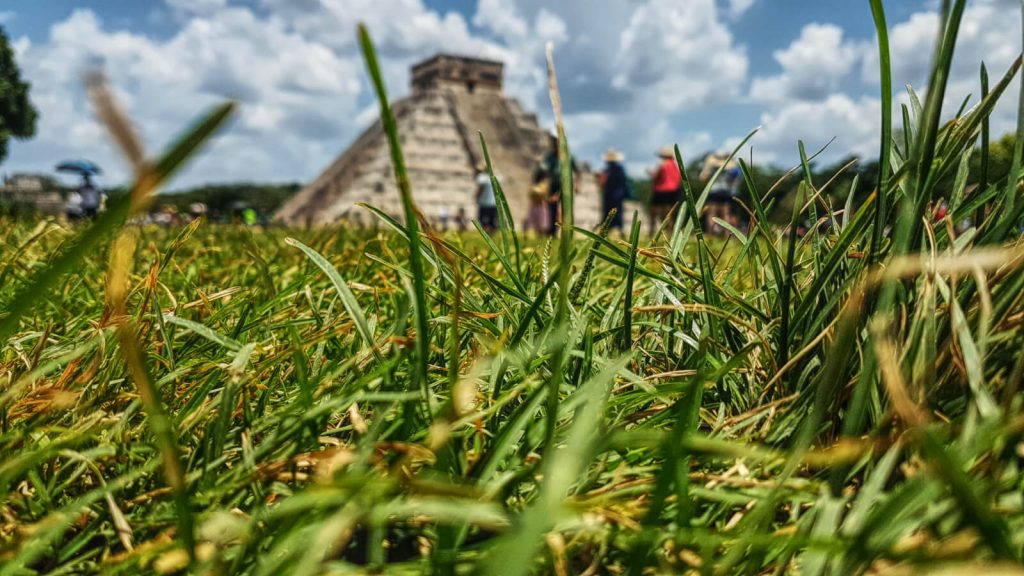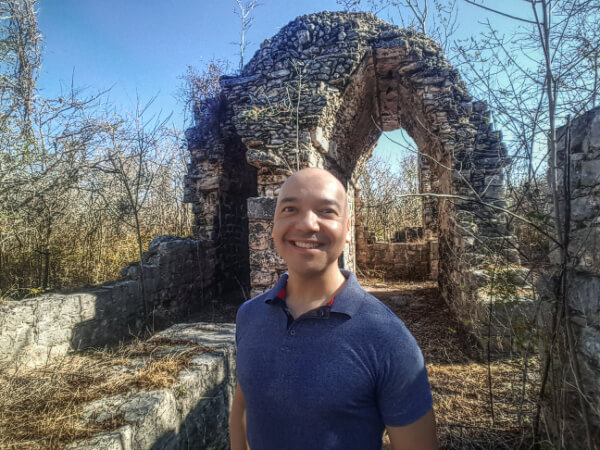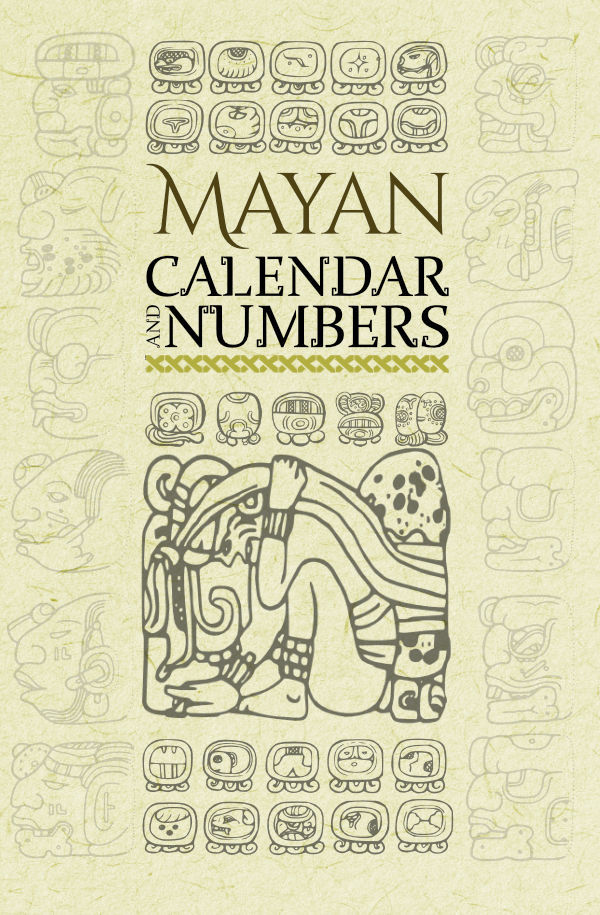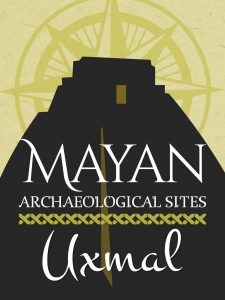Chichen Itza is the most visited Archeological Site in the Mayan Culture and represents the most complete and spectacular example of the combination of Mayan and Toltec cultures that flourished and reached a remarkable extension under the influence of “colonizers” from Tula.
The archaeological sources and the historical tradition, offer interesting indications for the study of the architectural and stylistic aspects of this Yucatán City, characterized by the evident mixture of two different cultures.
In Chichen Itza, numerous decorative elements, especially in the form of sculptures and stone bas-reliefs, testify to the strong presence of the cult of Quetzalcoatl, known as Kukulkan to the Mayas. The worship of the Sacred Cenote remained alive until the time of the conquest, a well to whose murky and deep waters victims were thrown to please the god of Rain Chac.
Facts about Chichen Itza are one of the most interesting and basic things to learn when visiting this Mayan Archeological Site. Learn 10 Facts about Chichen Itza from the Pyramid in Chichen Itza, the Sacred Cenote, and speaking about the Pyramid and the Cenote, did you know there’s a hidden Cenote right under the Great Pyramid of Chichen Itza?
Learn more about this fact and many more in this list I’ve written for you.
Chichen Itza open hours?
Chichén Itzá is open daily from 8 am to 5 pm. (Closing time may vary between 4 pm and 5 pm depending on the season)
When visiting most of the Mayan archeological sites you need to pay 2 fees, one for the Yucatán Tax Administration Agency, and a second one for the National Institute of Arts and History.
How much is Chichen Itza’s entrance fee in 2022?
General Admission
State fee: $453 MXN
Federal fee: $80 MXN
Total: $533 MXN
(Children between 3 and 12: $85 MXN)
| Mexican Citizens | Yucatán State Residents |
| State fee: $157 MXN Federal fee: $80 MXN Total: $237 MXN | State fee: $0 MXN Federal fee: $80 MXN Total: $80 MXN |
Free admission
- Free admission for Mexican Citizens on Sundays with a valid ID.
- Free admission every day for Mexican Citizens with the following valid IDs: Older than 60 years, retired, pensioned, teachers, students, children under 13, and handicapped.
When is the best time to visit Chichen Itza?
Chichen Itza is the second most visited archeological site in México with more than 2.5 million visitors a year, with the busiest months being November – to April.
The months with fewer crowds are May – June, and September – October.
The perfect month to visit this archeological site because of the good weather and fewer tourists in May.
The best time during the day is between 8 and 11 am, and if you’re not an early bird, you can get there between 2 and 3 pm.
What’s the estimated time spent in Chichen Itza?
Relax: You can walk around the Pyramid of Kukulkan to see the buildings without going into the Sacbés or roads in just under one hour.
Tourist: If you want to see everything stopping only to take pictures, it may take between 3 and 4 hours.
Archeologist: If you already read about Chichen Itza´s history and its buildings, you might want to really explore the architecture and engravings around the monuments. This may easily take between 4 to 6 hours.
General recommendations when visiting Chichen Itza?
1. Keep yourself hydrated
2. Wear comfortable shoes
3. Plan your route
4. Be patient
5. Protect yourself from harmful UV rays
6. Avoid large crowds
7. No drones or tripods allowed
8. Get a bus tour
9. Hire a guide (or not)
10. Something about salespeople
11. Bring cash
12. Bring mosquito repellent
Some of the Chichen Itza recommendations you find here may be common sense like drinking lots of water and protecting yourself from UV rays, but I recommend you read all of them to learn a couple of things you may not have thought about.
1. Keep yourself hydrated
The first of our Chichen Itza recommendations is to take a few liters of water in your backpack because you’re going to sweat, plus the weather is very hot and humid.
2. Wear comfortable shoes
You may wear sandals, but it’s best to take your hiking or tennis shoes. The pathways are a bit uneven and unpaved, also you’ll have to keep an eye out for errant rocks and sticks.
3. Plan your route
If you’re just looking to take a couple of amazing pictures in front of the main pyramid, and other nearby constructions, there’s no need to plan the route; but if you want to see everything, it’s best to plan ahead so you know what you want to see, and where it is.
4. Be patient
Lots of people visit Chichen Itza, and most of them get there between 11 am and 1 pm, so if you’re expecting to take a picture by yourself in front of the Kukulkan Pyramid, that may be a bit difficult. So, you can wait, or just take the picture and then edit your photo later.
5. Protect yourself from harmful UV rays
This is one of the most important Chichen Itza recommendations because you may find some shades under the trees, but most of the time, you will be under direct sunlight, so make sure to use sunscreen, a hat, and it may also be a good idea to take an umbrella with you.
6. Avoid large crowds
Chichen Itza can get very crowded depending on the season, schedule, and day of the week. There’s not much we can do about the season because we usually plan our trip depending on other factors, but try to avoid Sundays because any citizen with a valid Mexican ID gets in for free.
Another thing to look out for if you want to avoid large crowds in Chichen Itza is that most of the tour buses get there at around 11 am, so if it’s in your hands, try to get there at 8 am, or after 2 pm.
7. No drones or tripods allowed
This is one of the Chichen Itza recommendations that’s more of a warning, than a recommendation because you may freely take pictures and video with your handheld camera or smartphone, but you have to pay a small fee for shooting video with a pro camera. Also, keep in mind you can’t use drones.
If you really need to use a tripod, there’s special permission to use one, but it might take some valuable time out of your visit to get it.
8. Get a bus tour
While driving yourself may give you the freedom to stay the time you need and stop to eat wherever you want, it might be tiring for the driver. So, it might be a good idea to get a bus tour to Chichen Itza because most of them include the access ticket, a tour guide, food, and drinks, so you don’t have to worry about anything else other than enjoying your trip.
9. Hire a guide (or not)
This is one of the Chichen Itza recommendations that is totally up to you and what you want to get out of your trip to this Mayan Archeological Site.
Other than taking amazing pictures, a must when you visit Chichen Itza is to know what you’re looking at and a little bit of history. So, you have 2 options, read before you go, or hire a tour guide.
10. Something about salespeople
There are souvenir stands everywhere, selling figurines, t-shirts, wood carvings, and the list goes on. It’s important to buy from them and not big chain stores because some of the articles you can find there are works of art that were built with their own hands, plus you help their economy, but in my opinion, I don’t think there should be so many of them, this amazing Archeological Site ends up looking like a market.
Also, a few of them lie to get your attention, they may say something like 5 T-shirts for $5 dollars, and when you ask, they say 5 T-shirts for $25 dollars, making it seem like you may have heard wrong. Or they have a big figurine and offer it to you at $1 dollar, and when you approach them to buy it, they have a small one “hidden” in the other hand; then they tell you that’s the one that costs $1 dollar, and the big one costs $30.
11. Bring cash
While traveling in México, it’s always best to carry cash because you never know when you can pay with a credit or debit card. Even when they accept them, they may not work properly, try to carry cash with you.
12. Bring mosquito repellent
It depends on the season, but most of the year there are lots of mosquitos, one of the most important Chichen Itza recommendations is to take with you some mosquito repellent in the form of liquid, bracelet, sticker, or whatever works for you.
Housing Periods
The most important housing period of Chichen Itza has been divided into three; one corresponding from the years 550 to 800 which corresponds to a stage of pure Mayas; another from 800 to 1000 known as transitional, where the settlers from central Mexico arrived and brewed a new culture with the Maya, now called Mayan-Toltec; and the last one from 1050 to 1300 corresponding to the decline of the city.
Architectural and stylistic aspects of Chichen Itza
The archaeological sources and the historical tradition, offer interesting indications for the study of the architectural and stylistic aspects of this Yucatecan City, characterized by the evident mixture of two different cultures.



In Chichen Itza, numerous decorative elements, especially in the form of sculptures and stone bas-reliefs, testify to the strong presence of the cult of Quetzalcoatl, known as Kukulkán to the Mayas.
Kukulkan, the Mayan new god
It was probably the Toltecs who superimposed the anthropozoomorphic figure of this ancient and mysterious divinity, the legacy of the Teotihuacan civilization, its cultural hero Ce Acatl Topiltzin Quetzalcoatl, the mythical king of the legendary city of Tula, identified by so many archaeologists with the city of modest dimensions brought to light in the state of Hidalgo. Quetzalcoatl, after many years of reign over the city of Tula and its inhabitants, was dethroned by his evil brother Tezcatlipoca, an event that according to sources occurred in the year 987.

Different traditions are intertwined and superimposed on the fate of this civilizing hero, after his expulsion from Tula; according to one of them, he emigrated eastward, with a group of followers, to the territory of Yucatan, which he probably reached by sea. This is consistent with Yucatecan documents from the colonial era, which narrate the arrival to Chichen Itza of a character of noble lineage, cultured and refined, which the Maya gave the name of Kukulkán, which in Yucatec means precisely “snake-quetzal”, or more simply “Feathered Serpent”.
No doubt he brought to Chichen Itza much knowledge, especially in the field of arts and medicine, as well as the culture of his hometown, whose assimilation by local people must have given great impetus and prosperity to the city.
Many historians have interpreted oral tradition and colonial sources as the “fictionalized” reflection of events actually occurring; the “invaders” of Chichen Itza were probably exiled from Toltec lineage, expelled from Tula. Since the end of the tenth century, then, Chichen Itza assumed the role of the guiding city of Yucatán; its architecture represents a hybrid of the elements inherited from the Classic Maya, elements of Puuc style, and new Toltec contributions.
Human sacrifices in Chichen Itza

What inevitably surprises and impresses those who stop to visit the vestiges of this prestigious archaeological zone are aspects of material culture linked to human sacrifices; they were always practiced in Yucatan and other Mayan regions and the Toltecs further accentuated these rituals as seen in the altar of skulls where the heads of the decapitated victims, the Tzompantli, were nailed.
Best time to visit Chichen Itza
The Best time to visit Chichen Itza depends on your schedule and likes because you might like large crowds or be the only one there. For large crowds go on the Chichen Itza Equinox or a Mexican Holiday, if you can’t schedule these days, just visit between 11 am and 2 pm to get the largest crowds.
On the other hand, if you like to be practically the only one there, visit Chichen Itza on a rainy day and be there at 8 am. Check out the rest of this article to choose the best time to visit Chichen Itza.
General Weather in the State of Yucatan
Chichen Itza is located in the Yucatán Peninsula south of the Tropic of Cancer and is surrounded by warm tropic waters from the Gulf of México and the Pacific Ocean which means it has warm and humid tropical weather.
The Temperature in Chichen Itza
The temperatures in the Mayan Peninsula are very high and constant throughout the year between 28ºC in December-January and 35ºC in May-August.
Rain and hurricanes
The Mayan Peninsula has two rainy seasons between May and October, and between November and April, of course, this season may come before and after these months.
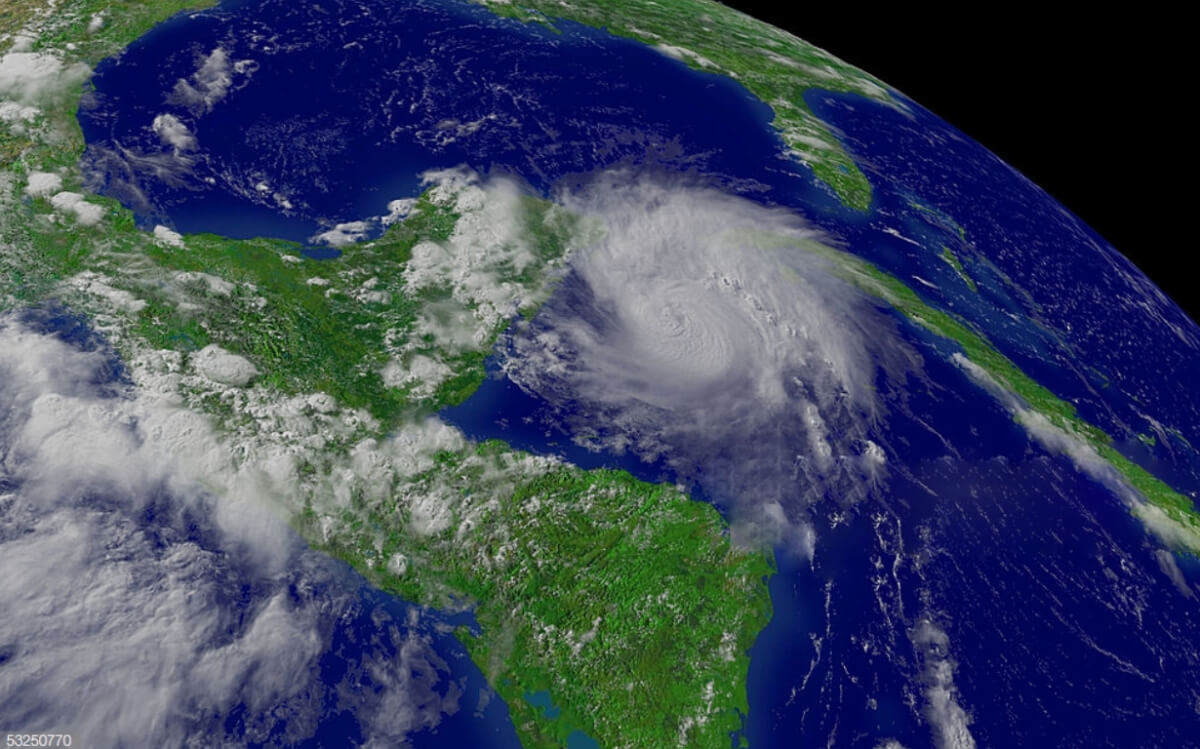
Since there are no mountains in the Mayan Peninsula, hurricanes have no obstacles to slow them down, which makes the land vulnerable to tropical storms and hurricanes coming from the East. The tropical hurricane season starts in May and ends in December.
The best months to visit Chichen Itza
The best time to visit Chichen Itza according to the months is between March and May because there’s not a lot of rain and there’s also not that much tourism.
After these months, the second-best time to visit Chichen Itza is between December and February because of the weather, but the downside is that there are a lot of tourists, so try to get there early.
Best hours to visit Chichen Itza
The best time during the day is between 8 and 11 am, and if you’re not an early bird, you can get there between 2 and 3 pm.
Worst time and day to visit Chichen Itza
The worst hours to visit Chichen Itza are between 11 am and 3 pm when most of the tour buses arrive.
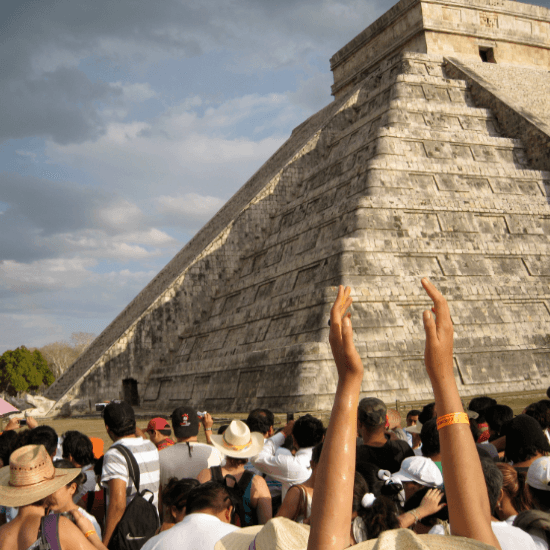
The worst day to visit Chichen Itza is on Sundays when every person with a valid ID from México can get it for free.
Another bad option that mostly depends on you, is the Chichen Itza Equinox because it may get very crowded. If you want to see it, I recommend visiting the site one or two days before and after. You can still enjoy the effect, but with fewer crowds.

Location of Chichen Itza
Chichen Itza is located in the State of Yucatan in Mexico, 120 km southeast of its capital Merida, and 200 km southwest of the city of Cancún.
How to get to Chichen Itza
You can arrive in a comfortable and safe way, using any means of transportation like tour buses, car rentals, or public transportation.
Chichen Itza Tours


You can get a complete experience of Chichen Itza with the hiring of a Tour Agency like Xichen by Xcaret that can offer you different packages with everything to turn your trip to Chichen Itza into a unique experience.
The Classic Chichen Itza Tour will provide full transportation either by bus or van from the hotel where you’re staying or from any other pick-up point. The tour includes the price of the tickets with a guide included, which will give you a tour through the site with breaks for free time.
The guides are certified and speak English, some of them even speak multiple languages.
Most tours will also visit cenotes and a delicious buffet-style meal in a restaurant of excellent regional quality.
Car Rental to go to Chichen Itza
With this option, you can take the wheel and make the journey with the stops you want and the way you want.
If you decide to rent a vehicle to make the trip to Chichen Itza, you can get an excellent price for the rental of your vehicle from an authorized website like rentalcars.com, getting a discount if you set it aside in advance.
Once you get your vehicle, the trip to Chichen Itza will not be complicated, you just have to take the 180 federal highway known also as the Mérida-Puerto Juarez highway. As for the conditions of the road, you should not worry because it is in perfect condition. Along the route, you can make stops in many tourist places, such as famous cenotes or tourist spots that offer beautiful crafts, perfect as souvenirs of your visit.
If you’re driving yourself, you can easily use apps like Google Maps or Waze to get there.
Public Transportation to Chichen Itza

If you want to get to Chichen Itza using public transportation, you can take buses, which are an economical and convenient option to get to your destination regardless of the number of people in the group. Buses are taken from the bus terminals in any city like Cancún or Mérida and should be taken in the morning as early as possible. By choosing this option, you can enjoy your trip in nice and spacious seats with air conditioning.
Public transportation usually stops in a beautiful town called Pisté located 15 kilometers from the ruins of Chichen Itza where you can buy ornaments and crafts to remember your trip and stretch your legs before continuing.
How to get to Chichen Itza from Merida
From Merida, it’s 120 km and you get there in approximately 1 hour and 30 minutes.
How to get to Chichen Itza from Valladolid
From Valladolid, it’s 50 km and you get there in approximately 45 minutes.
How to get to Chichen Itza from Cancun
From Cancun, it’s 200 km and you get there in approximately 3 hours.
How to get to Chichen Itza from Tulum
From Tulum, it’s 150 km and you get there in approximately 2 hours.
5 recommendations if you’re driving to Chichén Itzá
The Chichen Itza recommendations may change if you’re driving there with new options like taking control of the time you get there and leave, staying there as long as you need, and some other ones.
Check out these specific Chichen Itza recommendations in case you rented a car or a friend is showing you around the Mayan Peninsula.
1. Get there early (or late)
Try to get there between 8 and 10 am because most tour buses arrive between 11 am and 1 pm, plus it’s not that hot when you arrive that early.
If you’re not an early bird, try to get there between 2 and 3 pm, when the tour buses start to leave.
2. Look out for expensive toll booths
There are also a couple of expensive tolls along the way, depending on where you’re staying, so bring some extra cash with you.
3. Time your trip
Depending on where are you staying (from Mérida: 1:30 hours, and from Cancún: 2:30), you should time your trip. For example, if you want to get there at 8 am from Cancún, you should leave at around 5:30 am.
4. Leave on a full tank
You may find some gas stations along the way, but it’s better to just fill up your tank before you leave so you don’t have to stop.
5. Car A/C is a must
If you rent a car, make sure it has a working A/C, even while driving at high speed on the highway, you may need to cool off.
5 Recommendations when traveling to Chichen Itza with children
When traveling to Chichen Itza with children, you should keep in mind that not all children are fascinated by the idea of going to explore archaeological ruins, but that does not mean that you have to miss the opportunity to visit them. That’s why I leave you a list of recommendations that will make your visit and that of your little ones more pleasant.
1. Stroller

Although the roads are quite irregular, your trip to Chichen Itza with children is possible by walking on the most traveled roads with a stroller, preferably with a stroller with large wheels so that it does not get stuck with stones or branches. A stroller can also be very helpful to help you carry all the things like water, diapers, or even if your children want to rest and you want to continue exploring.
2. Rest in the shadows
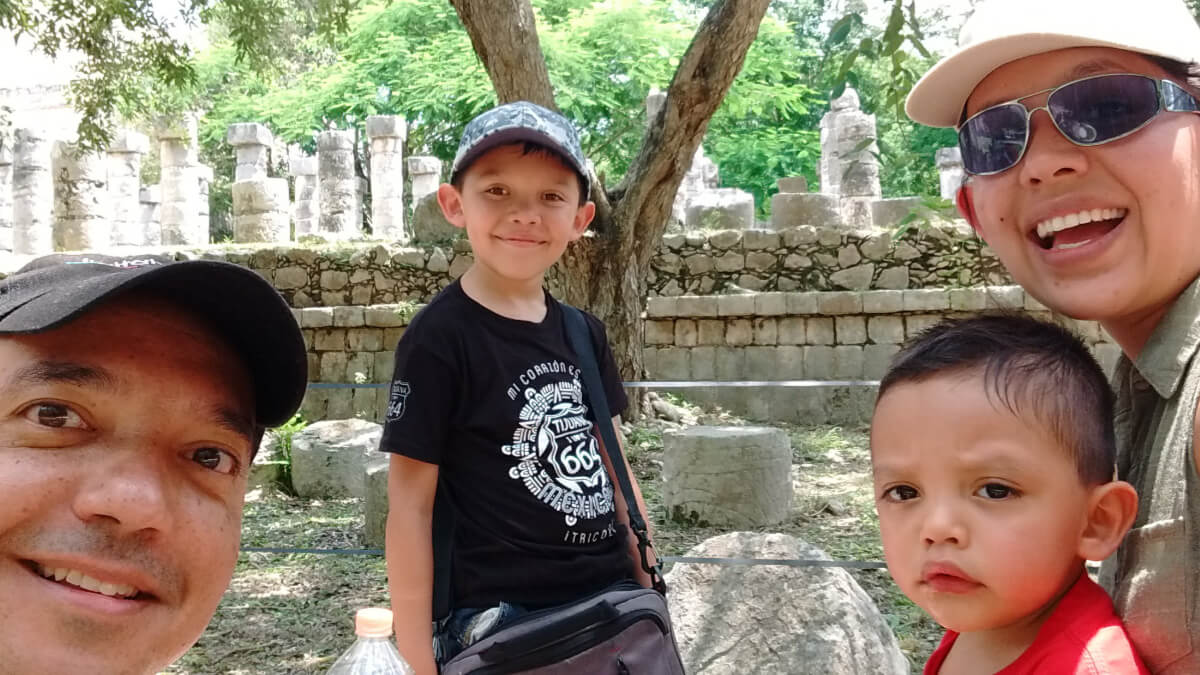
There are several places with benches and shadows so I recommend stopping from time to time, in that way, children have the opportunity to cool off, drink water, and you can marvel at the sight of the ruins.
3. Refreshing snacks
Within the archaeological zone, you will find several places where they sell, ice pops, ice cream, fruit, among other things. Carry some cash so you can pamper your kids with something refreshing.
4. Wet wipes
Wet wipes are a great help to cool off, or to clean your hands whenever necessary, although there are public toilets, they are usually very crowded and far so you cannot take them to wash their hands every time they get dirty.
5. Extra entertainment
It does not matter if you go from Cancun, the Mayan Riviera, or Merida, the trip is long and it is good that they bring something to entertain themselves, they can watch a movie, play with a Tablet or carry a toy. In the case of the Tablet and electrical devices, you must be
I hope that with these little tips for your next trip to Chichen Itza with children you can go more prepared to enjoy this wonderful place as a family.
Facts about Chichen Itza
Fact 1. A Cenote under the main pyramid of Kukulkan
This is the most recent of our top 10 Facts about Chichen Itza. In August 2015, archaeologists discovered a cenote under the Kukulkan pyramid.
This finding confused the researchers, but for an archaeologist expert in submarine archeology, the answer was simple:
The Mayans knew about the existence of the cenote and built the pyramid over it because the Mayans wanted to represent the universe with their constructions.
The pyramid rises equidistantly between four cenotes, one to the north, another to the south, another to the east, and the fourth one to the west.
This new finding would be the fifth cenote, the “axis mundi“, the point where the Sacred Ceiba grew its roots that reached the underworld, and its branches reached the four cardinal points.
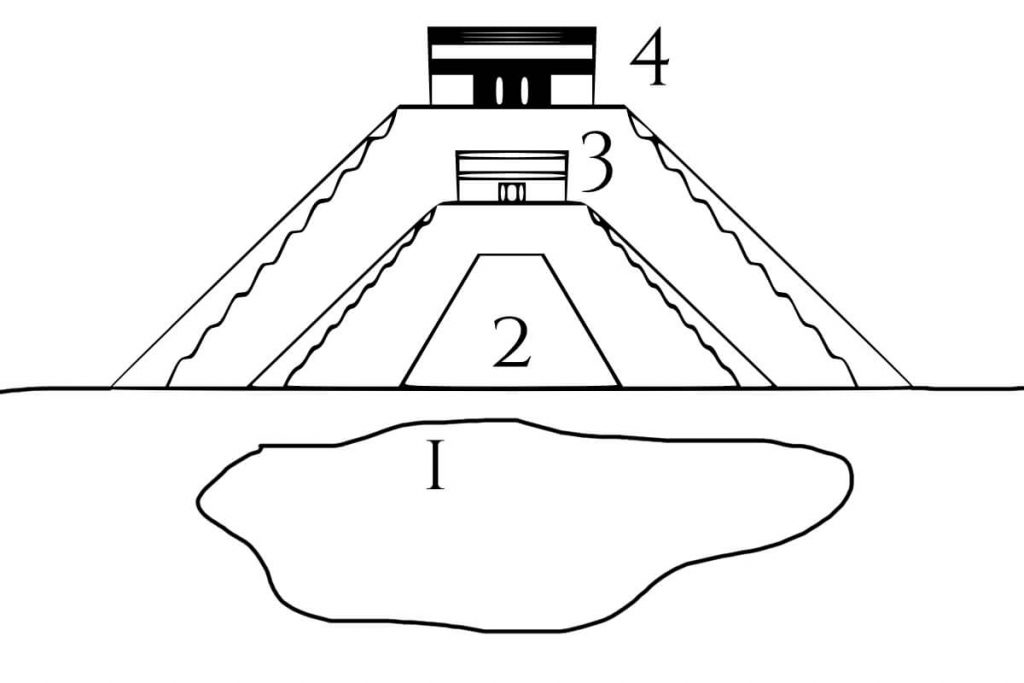
Fact 2. The layered Pyramid of Chichen Itza
Like other pre-Hispanic archaeological sites, constructions of the cities were covered during a second, and sometimes more residential phases.
In this case, the first Pyramid in Chichen Itza was built between the years 500 and 800; and again, by the third and currently visible stage, developed over the years. 1,050 and 1,300.
Fact 3. Ceremonial objects at the bottom of the Sacred Cenote
Various research teams have found ceremonial objects at the bottom of the Sacred Cenote, along with animal and people bones whose ages range from 3 to 55 years.
Its origin, however, is uncertain. There are theories that the Mayas practiced human sacrifices; others believe that in reality, these remains reached the bottom of the cenote as part of funerary rituals that would have arrived thereafter they had died.
Others say that the purpose of throwing living beings was not to cause their death but to get them to intercede with the lords of the underworld.
What they do agree on, is that all these rituals were intended to mediate with the entities of Xibalbá to ensure rain and good harvests.

Fact 4. The Sound of the Quetzal
There is an electroacoustic effect that occurs in front of a staircase of the main Pyramid of Kukulkan in Chichen Itza. When a person claps, the sound bounces in the form of a distorted echo and generates a sound that simulates the singing of a Quetzal.
This new attraction was discovered at the end of the twentieth century by the tour guides of the site.

Fact 5. The Pyramid of Kukulkan has a total of 365 steps
The temple of Kukulkan has four staircases, of 91 steps each, which is a total sum of 364. With the upper platform, it adds up to 365 in total.
Each step represented the days of the Haab Mayan calendar, which fits perfectly with the calendar we use today, the Gregorian calendar.
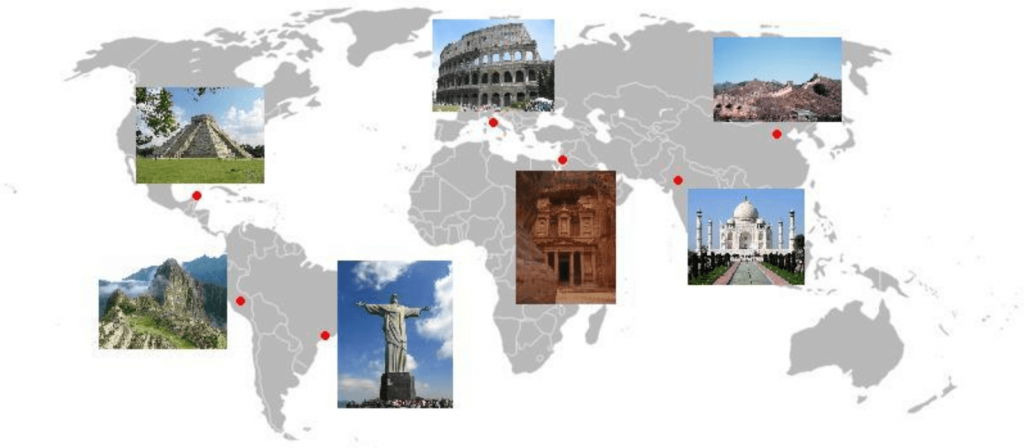
Fact 5. A World Heritage Wonder
Chichen Itza was declared a World Heritage Site by UNESCO in 1988 and in 2007, it was considered one of “The New Seven Wonders of the Modern World”, as part of a private initiative where people chose the sites that interested them the most.
Fact 6. Chichen Itza was bought by an American

At the beginning of the 20th century, the American Edward Herbert Thompson bought the property where Chichen Itza is located, mainly to drain the Sacred Cenote and extract numerous objects like jewelry and utensils made of gold, copper, and jade.
After various actions from the Mexican government, today it is owned by the State of Yucatan.
Some of the archaeological pieces discovered by Thompson were also returned to Mexico.
Fact 7. The largest Ball Court in Mesoamerica

The Ball Court of Chichen Itza is the largest in Mesoamerica, 70 meters wide and 169 meters long.
The idea of this game was to put a rubber ball through the hoop that is on top of the wall, using the elbows, knees, and faces.
Fact 8. The descent of the feathered serpent
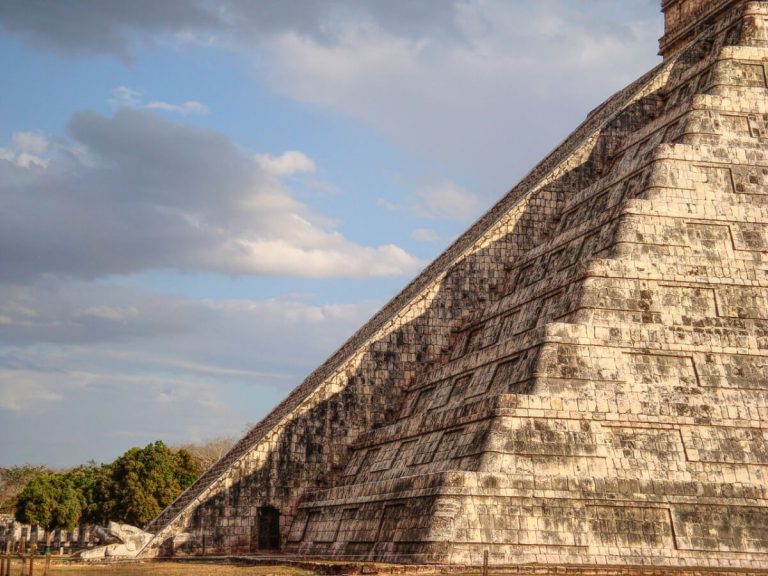
The last, and most well-known of our Facts about Chichen Itza list is the descending serpent.
The design of this pyramid was made by the Mayan architects who so well mastered the knowledge of the stars and in particular that of the sun.
For this reason, they placed the pyramid so that its shadow could be projected on the sides of the staircase, giving shape to the body of one of its deities, Kukulkan, the feathered serpent whose head is sculpted at the foot of the Pyramid.

Kukulkan Group
The Kukulkan Group is the first set of buildings you see when you enter from the main access and it’s made up by:
- The Kukulkan Pyramid
- The Great Ball Court
- Temple of the Jaguar
- The Great Ball Court’s South Temple
- The Temple of the Bearded Man
- The Tzompantli
- The Temple Eagles and Jaguars
- The Venus Temple
- The Sacred Cenote
The 1000 Columns Group
The 1000 Columns Group is located south-east of the Kukulkán Group and its main building is the Temple of the Warriors. This area is known for its many columns, it doesn’t really have 1000, but it sure seems like it.
- Temple of the Warriors
- The Temple of the Tables
- Group of the Thousand Columns
- North Pillars
- The Temple of Sculpted Columns
- The Market
The Ossuary Group
The Ossuary Group is located south of the Kukulkán Group and its main building is The Ossuary. This area is mostly ignored by visitors because it’s on the way to the Observatory, but you can visit the less-known buildings like the Tomb Platform and Chichanchob.
Here’s the list of buildings you can find in this group:
The Nunnery Group
The Nunnery Group is located south of the Ossuary Group and its main building is The Nunnery. This is the last of the groups we can visit, there’s another group known as Old Chichén south of this one, but it’s closed to the public.
The buildings you can find in the Nunnery Group are:
Balamku Cave in Chichen Itza

The Balamkú Cave in Chichén Itzá, which was discovered 50 years ago but remained unexplored until now, is a labyrinthine path with a depth of 24 meters below the surface.
This is a discovery of at least 200 ceramic pieces that remained intact for more than a thousand years in an underground ritual cave in the Mayan city of Chichén Itzá, in the current state of Yucatán.
Balamkú means “jaguar god”, in allusion to the divine quality that the ancient Mayans attributed to this animal, which they believed had the ability to enter and leave the underworld.

Location of the Balakmú Cave
The Balamkú Cave is located 2.7 kilometers east of the pyramid of El Castillo, also known as the Temple of Kukulkan, one of the seven wonders of the modern world.
The Findings in the Balakmú Cave
The project’s head researcher pointed out that the most important part of this finding is that it’s not altered, it’s not looted, and that all the information was still found in the Balamku Cave.

The vast majority of objects found are censers dedicated to Tlaloc, the Mesoamerican god of water, used for rituals and offerings in the Late Classic Maya period (600-900 AD).
The archaeologist explained that several investigations like this one have discarded the initial hypothesis of a Toltec invasion of the Maya and reaffirmed that there must be an influence from the center of Mexico towards Chichen Itza.
The archaeological artifacts belong to seven offerings documented so far and are in good condition since the cave remained sealed for centuries.
The incense burners and vessels discovered in the Balamku Cave still preserve charred remains, food, seeds, jade, shell, and bones, among other elements that the Maya offered during that time to their deities.
The importance of the Cave
The difficult access and morphology of the cave hindered the deposition of these pieces and the celebration of rituals, the reason why the researchers consider that it was a space of great relevance for the Mayans of Chichen Itza.
The archaeologist even thinks that this cave is probably more sacred than the Sacred Cenote itself. He considered it was more important because the effort that represents entering is greater than in the Sacred Cenote, which received offerings from all of Mesoamerica and there were pilgrimages.
The size of the Balamkú Cave

So far, there has been a preliminary exploration of the first 450 meters of the cave, although it’s estimated that this route would be equivalent to one-third of the actual length.
The researchers are working on the development of a three-dimensional model of the cave under the premise of avoiding any modification.

